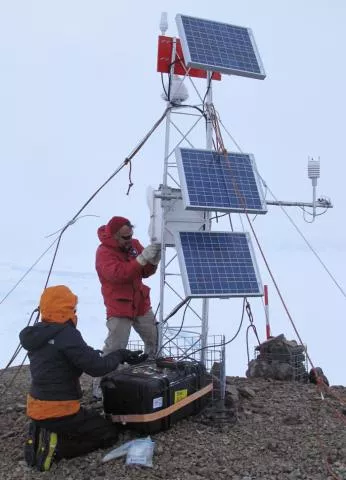This is a media advisory from the National Snow and Ice Data Center, which is part of the Cooperative Institute for Research in Environmental Sciences (CIRES) at the University of Colorado Boulder.
Researchers from the National Snow and Ice Data Center (NSIDC) will test a new type of weather and water measurement station on a frozen lake in Colorado. The multi-sensor station is designed to measure weather, snow conditions, water currents, and temperatures where Antarctica’s ice shelves meet the Southern Ocean.
The multi-sensor station is a prototype that is being proposed for installation in several Antarctic regions where changing ocean circulation has brought above-freezing water in contact with the coastline of the Antarctic ice sheet. This leads to rapid melting and faster glacier ice flow off the continent, potentially raising sea level by several inches in this century.
A network of these stations would allow scientists to better understand how ocean currents and wind shifts in the far southern continent are affecting the ice sheet, and would support better predictions of how fast the ice will melt.
The researchers will be testing the station February 21 to 26 on Grand Lake, about two hours northwest of Denver. They will set up the station on the ice and will lower a wire line with ocean instrumentation through a hole in the ice to about 160 feet.
The multi-sensor station is called the Automated Meteorology-Ice-Geophysics Observing System-II or AMIGOS-II. Sensors for air temperature, wind speed, barometric pressure, snow temperature, water temperature, water salinity, and water flow are attached to a 20-foot aluminum tower. An onboard GPS measures any movement of the station on the ice. The station includes a camera to report sky conditions, snowfall events, and storms. Data from the station are sent to NSIDC using a satellite phone system.
The principal investigator for the effort is NSIDC lead scientist Ted Scambos. The team will be led by Rob Bauer, associate scientist at NSIDC. The team includes NSIDC associate scientist Marin Klinger; Tim White, an undergraduate student at the University of Colorado Boulder; Ronald Ross, at Polar66 Engineering, who designed the AMIGOS-II system; and Jennifer Bohlander, a researcher at Polar Science Consultants. The researchers will be assisted by Jim White, town manager at Grand Lake; Jim Gasner, a local fishing guide; and Christopher Brown and Dan Matthews of the U.S. Forest Service.
Media contacts
Marin Klinger
+1 (503) 758-6872
marin.klinger@nsidc.org
Rob Bauer
+1 (303) 492-2378
bauer@nsidc.org
-end-
